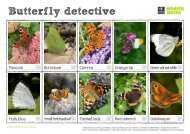CHOBHAM COMMON NNR - Surrey Wildlife Trust
CHOBHAM COMMON NNR - Surrey Wildlife Trust
CHOBHAM COMMON NNR - Surrey Wildlife Trust
You also want an ePaper? Increase the reach of your titles
YUMPU automatically turns print PDFs into web optimized ePapers that Google loves.
2.2 SITE MANAGEMENT<br />
2.2.1 Introduction<br />
“Lowland heathland is characterised by the presence of plants such as heather,<br />
dwarf gorses, and cross-leaved heath and is generally found below 300 metres in<br />
altitude. Areas of good quality heathland should consist of an ericaceous layer of<br />
varying heights and structures, some areas of scattered trees and scrub, areas of<br />
bare ground, gorse, wet heaths, bogs and open water.<br />
Lowland heathland is a priority for nature conservation because it is a rare and<br />
threatened habitat. In England only one sixth of the heathland present in 1800 now<br />
remains. The UK has an important proportion (about 20%) of the international total of<br />
this habitat.<br />
In the past heathland was lost primarily to agriculture, forestry, mineral extraction and<br />
development. Uncontrolled wild fires have also been a particular threat to bryophyte<br />
and lichen-rich heathland. The main factors affecting the habitat at present are the<br />
encroachment of trees and scrub and the simplification of vegetation structure due to<br />
a lack of conservation management such as light grazing, controlled burning and<br />
cutting. Nutrient enrichment, particularly deposition of nitrogen compounds,<br />
fragmentation and disturbance from developments such as housing and road<br />
constructions 4 .<br />
2.2.2 Scrub and Woodland encroachment<br />
Without regular management most heathlands will rapidly be lost to either bracken<br />
dominated communities or to encroaching trees and scrub, mostly birch Betula ssp.<br />
and Scots pine Pinus sylvestris (Gimingham, 1972;Power pers. comm.; Marrs, Hicks<br />
& Fuller, 1986),. Most European heathlands including those in the UK were originally<br />
derived from woodland (e.g.Dimbleby, 1962; Kaland, 1986; Odgaard, 1994) but<br />
following the clearance of trees, human activities such as farming, grazing, cutting<br />
and turf-stripping have kept the heaths open. Although the resulting heathland soils<br />
have lost their bases and some of their nutrients from the leaching effects of<br />
rainwater, these nutrient poor and acid soils are still capable of supporting trees<br />
particularly when there are nearby seed sources and adequate phosphorus<br />
availability in the soils (Manning, Putwain & Webb, 2005). Invasion by trees and<br />
scrub has been seen as one of the main threats to heathland in recent years and was<br />
one of the mainsprings for the successful European bid for funding for 38 projects<br />
across the southern counties under `The Tomorrows Heathland Heritage’ initiative<br />
led by English Nature.<br />
2.2.3 Atmospheric nutrient inputs<br />
Airborne nitrogen (as ammonia and nitrous oxides) from burning fossil fuels by<br />
industry, traffic, aviation, shipping and agriculture pose one of the greatest threats to<br />
heathland in Europe. Heathland systems are generally poor in nutrients and many of<br />
the plant species can only survive and compete successfully on soils with low<br />
nitrogen availability (Bobbink et al., 2002). Nitrogen compounds also increase<br />
acidification in soils. The addition of nitrogen in rain or dust particles, results in an<br />
increase in the nitrogen in the vegetation, litter and upper soil layers, and this builds<br />
up over time. Heather growth can initially benefit from inputs of nitrogen, but where<br />
4 (Habitat Action Plan – Lowland Heath, Biodiversity: UK Steering Group Report,<br />
1995)<br />
26



![Thursley Common [Shrike Hill] (SU9041) & Sheets Heath (SU9457 ...](https://img.yumpu.com/11846073/1/184x260/thursley-common-shrike-hill-su9041-sheets-heath-su9457-.jpg?quality=85)

